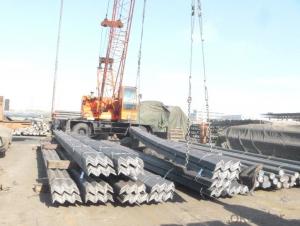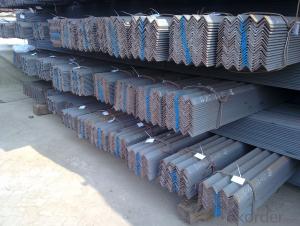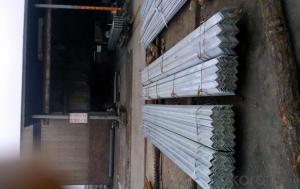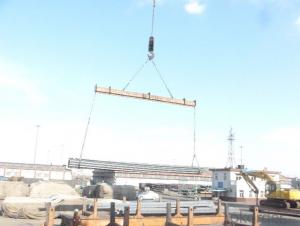hot rolled angle steel
- Loading Port:
- China Main Port
- Payment Terms:
- TT OR LC
- Min Order Qty:
- -
- Supply Capability:
- -
OKorder Service Pledge
OKorder Financial Service
You Might Also Like
Product Description:
1.Grade: SS200,300,400 series
2.Size: 25×25×3 mm-100×100×10mm
3.Process: HRAP
4. Length: 2-6m
5. Shape: Equal
6. Delivery: within 20 days
7. MOQ: 1 ton
8. Certificate: ISO 9001:2008, SGS
9. Package:Standard Export Packing, or put into wooden boxes according to your requirement
10. Application: Construction, Marine, Industry and so on
Name | Stainless Steel Angles | ||||||
Standard | ASTM A554, A312, A249, A269 and A270 | ||||||
Material Grade | 304,316,201,202, 316L,430 | ||||||
Length | 6m or as customers' request | ||||||
Tolerance | a) thickness: +/-0. 15mm | ||||||
| |||||||
b) Length:+/-4. 5mm - 0mm | |||||||
Surface | 180G, 320G, 400G Satin / Hairline(Matt Finish, Brush, Dull Finish) 400G, 500G, 600G or 800G Mirror finish | ||||||
Application | Decoration construction, upholstery, industry instruments | ||||||
Test | Squash test, Extended test, Water pressure test, Crystal rot test, Heat treatment, NDT | ||||||
Chemical Composition of Material |
Composition
Material | 201 | 202 | 304 | 316L | 430 | |
C | ≤0.15 | ≤0.15 | ≤0.08 | ≤0.08 | ≤0.12 | | |
Si | ≤1.00 | ≤1.00 | ≤1.00 | ≤1.00 | ≤1.00 | | |
Mn | 5.5-7.5 | 7.5-10 | ≤2.00 | ≤2.00 | ≤1.00 | | |
P | ≤0.06 | ≤0.06 | ≤0.045 | ≤0.045 | ≤0.040 | | |
S | ≤0.03 | ≤0.03 | ≤0.030 | ≤0.030 | ≤0.030 | | |
Cr | 16-18 | 17-19 | 18-20 | 16-18 | 16-18 | | |
Ni | 3.5-5.5 | 4-6 | 8-10.5 | 10-14 |
| | |
Mo |
|
|
| 2.0-3.0 |
| | |
Mechanical Property | Material Item | 201 | 202 | 304 | 316L | | |
Tensile Strength | ≥535 | ≥520 | ≥520 | ≥520 | | ||
Yield Strength | ≥245 | ≥205 | ≥205 | ≥205 | | ||
Extension | ≥30% | ≥30% | ≥35% | ≥35% | | ||
Hardness (HV) | <253 | <253 | <200 | <200 | | ||
- Q: What are the different types of connections used for steel angles in industrial applications?
- In industrial applications, steel angles are commonly used for various structural purposes, and therefore, different types of connections are employed to ensure their stability and strength. Some of the different types of connections used for steel angles in industrial applications include: 1. Welded Connections: Welding is a widely used method to connect steel angles in industrial applications. It involves melting the edges of two steel angles together and allowing them to solidify, creating a permanent and strong connection. Welded connections provide excellent strength and durability, making them suitable for heavy-duty applications. 2. Bolted Connections: Bolted connections involve using bolts and nuts to secure steel angles together. Holes are typically drilled into the angles, and bolts are inserted through these holes and tightened using nuts. Bolted connections offer the advantage of being easily dismantled and modified, making them suitable for applications where frequent adjustments or repairs are necessary. 3. Riveted Connections: Riveting is a traditional method of connecting steel angles, although it is less commonly used in modern industrial applications. Riveted connections involve inserting a rivet through holes in the steel angles and then deforming the rivet to secure the angles together. Although riveted connections provide good strength, they are time-consuming and require specialized equipment. 4. Clip Connections: Clip connections involve using metal clips or brackets to connect steel angles. These clips are typically bolted or welded to the steel angles, providing a secure connection. Clip connections are often used in applications where quick and easy assembly and disassembly are required, such as temporary structures. 5. Gusset Plate Connections: Gusset plates are thin steel plates that are used to connect steel angles in industrial applications. These plates are typically bolted or welded to the steel angles, providing additional strength and stability. Gusset plate connections are commonly used in applications where higher loads or forces are expected. It is worth noting that the type of connection used for steel angles in industrial applications depends on various factors, including the load requirements, structural design, ease of assembly and disassembly, and the expected lifespan of the structure.
- Q: How do steel angles perform in high-temperature environments?
- Steel angles perform well in high-temperature environments due to their inherent properties. Steel is known for its high melting point and thermal conductivity, which allows it to withstand elevated temperatures without significant structural degradation. In high-temperature environments, steel angles maintain their strength and stability, making them suitable for various applications. One reason for the excellent performance of steel angles in high-temperature environments is their ability to retain their structural integrity. Steel has a high melting point, typically ranging from 1300 to 1500 degrees Celsius, depending on the specific grade. This property ensures that steel angles can withstand and maintain their shape even in extreme heat conditions. Furthermore, steel has a low coefficient of thermal expansion, meaning it expands and contracts minimally when exposed to temperature changes. This characteristic is vital in high-temperature environments as it reduces the risk of warping or distortion of steel angles. The dimensional stability of steel angles enables them to withstand thermal cycling without compromising their structural strength. Additionally, steel exhibits excellent thermal conductivity, allowing it to effectively dissipate heat. This property prevents the accumulation of excessive heat in steel angles, reducing the risk of thermal stress or failure. Steel angles efficiently transfer heat away from critical components, increasing their durability and longevity in high-temperature environments. Moreover, steel angles are often coated or treated with heat-resistant materials to enhance their performance in extreme heat conditions. These coatings provide an additional layer of protection against oxidation, corrosion, and thermal degradation, further improving the resilience of steel angles in high-temperature environments. In conclusion, steel angles are well-suited for use in high-temperature environments due to their high melting point, low thermal expansion, excellent thermal conductivity, and the possibility of additional heat-resistant coatings. Their ability to maintain structural integrity, dimensional stability, and heat dissipation make them a reliable choice for various applications where exposure to elevated temperatures is a concern.
- Q: Can steel angles be used for overhead cranes?
- Indeed, overhead cranes can utilize steel angles. The utilization of steel angles is widespread in the creation of overhead cranes as a result of their remarkable strength and rigidity. They play a vital role in furnishing the crane with structural support and stability, enabling it to handle substantial loads and endure the dynamic forces associated with lifting and transporting objects. The framework of the crane can be established by welding or bolting together steel angles, thus creating a resilient and long-lasting structure. Furthermore, steel angles can be effortlessly tailored and manufactured to satisfy the specific requirements of the overhead crane, including length, size, and angle. In summary, steel angles are highly favored for the construction of overhead cranes due to their exceptional capacity to bear heavy loads and their versatility in construction.
- Q: What are the safety considerations when working with steel angles?
- When working with steel angles, there are several important safety considerations to keep in mind. 1. Personal Protective Equipment (PPE): Always wear the appropriate PPE, including safety glasses, gloves, and steel-toed boots, to protect yourself from potential hazards such as flying debris, sharp edges, or heavy objects falling. 2. Lifting and handling: Steel angles can be heavy and cumbersome, so it is crucial to use proper lifting techniques and equipment to avoid strains or injuries. Use lifting aids such as cranes, hoists, or forklifts when necessary, and never attempt to lift or carry steel angles alone if they exceed a safe weight limit. 3. Sharp edges and burrs: Steel angles often have sharp edges and burrs that can cause cuts or abrasions. Use caution when handling them and consider deburring or filing down any sharp edges to reduce the risk of injuries. 4. Secure and stable work area: Ensure that the work area is clean, organized, and free from any tripping hazards. Steel angles should be stored securely to prevent them from falling or rolling onto workers or equipment. 5. Welding and cutting: If welding or cutting steel angles, be aware of the potential hazards associated with these processes. Use adequate ventilation or respirators to protect against fumes and ensure that the work area is clear of flammable materials. Follow proper safety protocols and use appropriate welding or cutting equipment to minimize the risk of fire, burns, or electric shocks. 6. Structural stability: When steel angles are used as part of a larger structure, it is crucial to ensure that the design and construction adhere to industry standards and codes. This includes properly securing the angles, verifying load capacities, and conducting regular inspections to identify any signs of structural weaknesses or defects. 7. Training and supervision: Workers should receive proper training on the safe handling, storage, and use of steel angles. Supervisors should actively monitor the work area and provide guidance to ensure that safety protocols are followed at all times. By following these safety considerations, individuals can reduce the risk of accidents and injuries when working with steel angles.
- Q: What are the different types of steel angles used in transmission towers?
- In transmission tower construction, there are three primary types of steel angles commonly employed: equal angles, unequal angles, and back-to-back angles. Equal angles, denoted as L-shaped sections, possess equal sides. They serve as cross-arms in transmission towers, providing structural stability and support. These angles are well-suited for bearing horizontal loads and are frequently utilized in the middle and upper regions of the tower. Unequal angles, as indicated by their name, possess unequal sides. They are utilized in transmission towers to enhance strength and stability in areas where load distribution is uneven. The longer side of the unequal angle is typically positioned on the side requiring greater strength. These angles are commonly used in the lower sections of transmission towers. Back-to-back angles are created by joining two equal angles together, forming a singular section. They are employed in transmission towers to augment strength and rigidity. Back-to-back angles find application in areas with non-uniform load distribution or where the tower must support heavier loads. These angles are commonly found in the base sections of transmission towers. The selection of steel angles for transmission towers depends on several factors, including tower height, load requirements, and specific design considerations. Engineers meticulously analyze these factors to determine the most suitable type of steel angle for each tower section, ensuring overall stability and strength of the transmission tower structure.
- Q: How do steel angles contribute to sustainable construction?
- Steel angles contribute to sustainable construction in multiple ways. Firstly, steel is an incredibly durable and long-lasting material, which means that structures built using steel angles will have a longer lifespan compared to those made with other materials. This reduces the need for frequent repairs or replacements, thus minimizing waste and reducing the overall environmental impact of construction. Secondly, steel is a highly recyclable material. At the end of a structure's life cycle, steel angles can be easily recycled and repurposed for other construction projects. This reduces the demand for new steel production, which is energy-intensive and can result in significant carbon emissions. Additionally, steel angles offer design flexibility, allowing architects and engineers to create more efficient and innovative structures. This can lead to optimized building designs that require less energy for heating, cooling, and maintenance, contributing to energy savings and reduced greenhouse gas emissions. Moreover, steel angles are lightweight yet incredibly strong, resulting in less material usage and reduced transportation costs. As a result, the overall carbon footprint associated with steel construction is lower compared to other materials. Furthermore, steel angles have excellent fire resistance properties, making them a safer choice for construction. This increases the longevity of structures and reduces the risk of damage or destruction during fires. Consequently, the need for rebuilding or reconstructing is reduced, leading to less material waste and environmental impact. In conclusion, steel angles contribute to sustainable construction through their durability, recyclability, design flexibility, energy efficiency, lightweight nature, fire resistance, and overall reduced environmental impact. By incorporating steel angles into construction projects, we can create more sustainable and environmentally friendly structures that benefit both the present and future generations.
- Q: What are the common loadings or forces that steel angles are designed to withstand?
- Steel angles are widely utilized in different structural applications because of their versatility and strength. These angles are engineered to endure various loadings or forces, depending on the specific application. Some typical loadings that steel angles are engineered to tolerate include: 1. Compression: Steel angles have the ability to withstand compressive forces, which are forces that tend to compress or squeeze the material. They are frequently employed in columns or supports to bear the weight of a structure or to resist crushing loads. 2. Tension: Steel angles can also endure tensile forces, which are forces that stretch or pull the material. They are commonly used in tension members, like roof trusses or bridge supports, to resist pulling or stretching loads. 3. Bending: Steel angles are designed to resist bending forces, which occur when a material is subjected to a combination of tension and compression. They are commonly used in beams or braces to provide structural stability and prevent excessive deflection or bending. 4. Shear: Steel angles have the capacity to withstand shear forces, which occur when one section of a material is pushed in one direction and another section is pushed in the opposite direction. They are frequently employed in connections or joints to transfer loads between structural members and resist shearing forces. 5. Lateral loads: Steel angles are also engineered to withstand lateral loads, which are forces that act horizontally on a structure. These loads can be caused by wind, earthquakes, or other external factors. Steel angles are often utilized in bracing systems to provide lateral stability and prevent the structure from overturning or collapsing. It is important to note that the specific loadings and forces that steel angles are engineered to withstand may vary depending on the size, shape, and grade of the angle, as well as the specific design requirements of the application. Therefore, it is crucial to consult the appropriate design codes and engineering guidelines to ensure the proper selection and application of steel angles in a given structural design.
- Q: How do you determine the appropriate length of a steel angle for a specific application?
- Determining the appropriate length of a steel angle for a specific application involves considering several factors. Firstly, you need to assess the structural requirements of the application. This includes analyzing the loads and forces that the steel angle will be subjected to. You should determine the maximum load capacity the steel angle needs to support and ensure that its length can adequately distribute the load without excessive deflection or failure. Secondly, you should consider the dimensions and layout of the application. Measure the available space and determine how the steel angle will fit within the overall structure. Consider any constraints such as adjacent components or obstructions that might affect the length of the steel angle. Next, you should consult relevant engineering and construction standards. Codes and guidelines provide recommended design values and specifications for steel angles based on their intended use. These standards can help you determine the appropriate length based on the application requirements and the material properties of the steel angle. Additionally, it is important to consider the fabrication and installation process. Evaluate the manufacturing capabilities and limitations, as well as any specific requirements for joining or fastening the steel angle. This will help determine if the desired length is feasible and practical in terms of fabrication and installation methods. Finally, it is advisable to consult with a structural engineer or a qualified professional in the field. They can provide expert advice and calculations based on the specific application, ensuring that the chosen length of the steel angle meets all necessary safety and performance requirements. In conclusion, determining the appropriate length of a steel angle for a specific application involves analyzing the structural requirements, considering the dimensions and layout, referring to relevant standards, evaluating fabrication and installation processes, and seeking professional guidance when needed.
- Q: What are the considerations for selecting the appropriate steel angle thickness?
- When selecting the appropriate steel angle thickness, there are several considerations to take into account. 1. Structural requirements: The first and most important consideration is the structural requirements of the project. This includes the load-bearing capacity, support requirements, and any specific design codes or standards that need to be followed. The steel angle thickness should be chosen in a way that ensures the structural integrity of the project. 2. Application: The application of the steel angle also plays a significant role in determining the appropriate thickness. Different applications have different demands in terms of strength, durability, and resistance to environmental factors. For example, if the steel angle is intended to be used in a corrosive environment, a thicker thickness may be required to provide better protection against corrosion. 3. Cost-effectiveness: Cost is always an important consideration in any construction project. While thicker steel angles may offer greater strength and stability, they can also be more expensive. It is essential to strike a balance between the required strength and the available budget to ensure cost-effectiveness. 4. Manufacturing and fabrication limitations: The selected steel angle thickness should be within the manufacturing and fabrication capabilities of the manufacturer. It is crucial to consider the availability of the desired thickness and the feasibility of producing the required dimensions. 5. Aesthetic considerations: In some cases, the appearance of the steel angle may be a factor to consider. Thicker angles may have a more substantial and visually appealing look, which can be desirable in certain architectural or design applications. 6. Availability and standard sizes: Availability of steel angles in different thicknesses and standard sizes can also influence the selection process. It is often more convenient and cost-effective to choose a thickness that is readily available in the market. In conclusion, selecting the appropriate steel angle thickness requires careful consideration of structural requirements, application demands, cost-effectiveness, manufacturing limitations, aesthetic preferences, and the availability of standard sizes. By taking all these factors into account, one can make an informed decision that meets the project's needs and ensures the desired level of strength and durability.
Send your message to us
hot rolled angle steel
- Loading Port:
- China Main Port
- Payment Terms:
- TT OR LC
- Min Order Qty:
- -
- Supply Capability:
- -
OKorder Service Pledge
OKorder Financial Service
Similar products
Hot products
Hot Searches
Related keywords




























